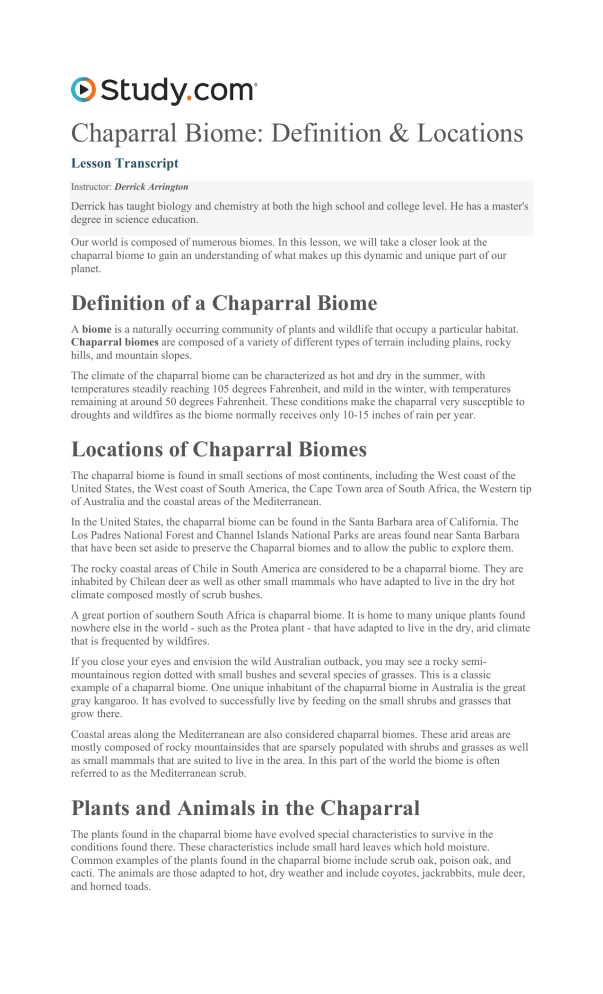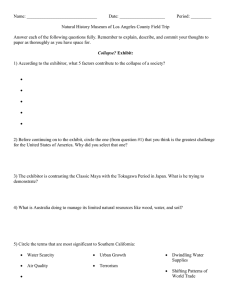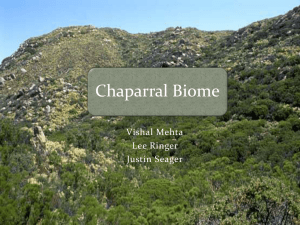Chaparral Biome: Definition, Locations & Characteristics
advertisement

Chaparral Biome: Definition & Locations Lesson Transcript Instructor: Derrick Arrington Derrick has taught biology and chemistry at both the high school and college level. He has a master's degree in science education. Our world is composed of numerous biomes. In this lesson, we will take a closer look at the chaparral biome to gain an understanding of what makes up this dynamic and unique part of our planet. Definition of a Chaparral Biome A biome is a naturally occurring community of plants and wildlife that occupy a particular habitat. Chaparral biomes are composed of a variety of different types of terrain including plains, rocky hills, and mountain slopes. The climate of the chaparral biome can be characterized as hot and dry in the summer, with temperatures steadily reaching 105 degrees Fahrenheit, and mild in the winter, with temperatures remaining at around 50 degrees Fahrenheit. These conditions make the chaparral very susceptible to droughts and wildfires as the biome normally receives only 10-15 inches of rain per year. Locations of Chaparral Biomes The chaparral biome is found in small sections of most continents, including the West coast of the United States, the West coast of South America, the Cape Town area of South Africa, the Western tip of Australia and the coastal areas of the Mediterranean. In the United States, the chaparral biome can be found in the Santa Barbara area of California. The Los Padres National Forest and Channel Islands National Parks are areas found near Santa Barbara that have been set aside to preserve the Chaparral biomes and to allow the public to explore them. The rocky coastal areas of Chile in South America are considered to be a chaparral biome. They are inhabited by Chilean deer as well as other small mammals who have adapted to live in the dry hot climate composed mostly of scrub bushes. A great portion of southern South Africa is chaparral biome. It is home to many unique plants found nowhere else in the world - such as the Protea plant - that have adapted to live in the dry, arid climate that is frequented by wildfires. If you close your eyes and envision the wild Australian outback, you may see a rocky semimountainous region dotted with small bushes and several species of grasses. This is a classic example of a chaparral biome. One unique inhabitant of the chaparral biome in Australia is the great gray kangaroo. It has evolved to successfully live by feeding on the small shrubs and grasses that grow there. Coastal areas along the Mediterranean are also considered chaparral biomes. These arid areas are mostly composed of rocky mountainsides that are sparsely populated with shrubs and grasses as well as small mammals that are suited to live in the area. In this part of the world the biome is often referred to as the Mediterranean scrub. Plants and Animals in the Chaparral The plants found in the chaparral biome have evolved special characteristics to survive in the conditions found there. These characteristics include small hard leaves which hold moisture. Common examples of the plants found in the chaparral biome include scrub oak, poison oak, and cacti. The animals are those adapted to hot, dry weather and include coyotes, jackrabbits, mule deer, and horned toads. Lesson Summary A biome is a naturally occurring community of plants and wildlife that occupy a particular habitat. Chaparral Biomes are composed of a variety of different types of terrain, including plains, rocky hills, and mountain slopes. The climate of the chaparral biome can be characterized as hot and dry in the summer, with temperatures steadily reaching 105 degrees Fahrenheit and mild in the winter, with temperatures remaining at around 50 degrees Fahrenheit. These conditions make the chaparral very susceptible to droughts and wild fires as the biome normally receives 10-15 inches of rain per year. The chaparral biome is found in small sections of most continents, including the West coast of the United States, the West coast of South America, the Cape Town area of South Africa, the Western tip of Australia, and the coastal areas of the Mediterranean. The plants found in the chaparral biome have evolved special characteristics to survive in hot, dry weather. Quiz 1. ____ Which of the following plants is not found in chaparral biomes? a. scrub oak b. tulip c. poison oak d. cactus 2. ____ Which of the following animals are adapted to live in chaparral biomes? a. sharks b. wild horses c. coyotes d. koalas 3. ____ Which U.S. state is home to a chaparral biome? a. Florida b. California c. Arizona d. Washington 4. ____ Chaparral plants usually survive fires because a. they contain oils that act as natural fire extinguishers. b. water is stored in their small, leathery leaves. c. they can resprout from small amounts of surviving plant tissue. d. they have deep root systems that keep them moist during a fire. 5. _____ Which of the following is located primarily in coastal areas that have Mediterranean-style climates with warm, dry summers and mild, wet winters? a. tallgrass prairie b. savanna c. tundra d. chaparral 6. ____ Which of the following describes the climate of the chaparral? a. Mediterranean climate; hot, dry summers; mild, wet winters b. desert-like climate; hot, dry summers; cool, dry winters c. extremely wet climate; cold, wet winters; cool, rainy summers d. relatively dry climate; mild, dry summers; cold, dry winters





